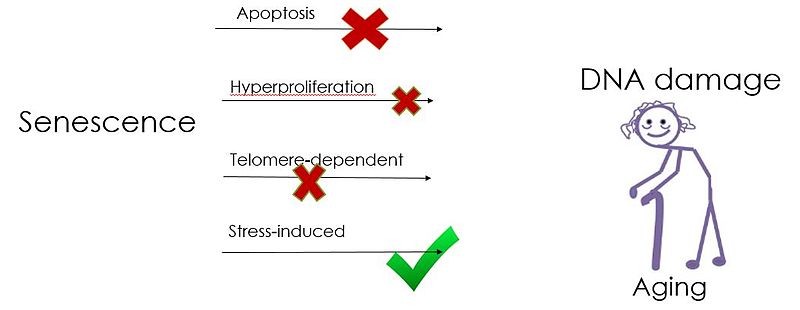Difference Between Aging and Senescence
Table of Contents
The key difference between aging and senescence is that aging is the process of deterioration of cells with time while senescence is a result of aging where the cells stop dividing and reach a state of arrest.
DNA damage leads to many critical outcomes. Although there are repair mechanisms in the body, certain damages cannot be repaired through these repair mechanisms. The accumulation of unrepaired DNA damages can lead to aging of cells, eventually leading to cell destruction. Senescence is the state where rapidly aging cells arrest, thereby preventing the continuation of the cell cycle.
CONTENTS
1. Overview and Key Difference
2. What is Aging
3. What is Senescence
4. Similarities Between Aging and Senescence
5. Side by Side Comparison – Aging vs Senescence in Tabular Form
6. Summary
What is Aging?
Aging is a gradual process by which a cell reaches senescence or cellular arrest. The aging process takes place due to the accumulation of damaged DNA. These damages lead to the deterioration of the cells. Furthermore, during the aging process, cells undergo various aging promoting mechanisms such as lipid peroxidation, protein misfolding and mitochondrial damage. They will lead to the deterioration of the cell wall and other cellular contents of the cell.

Figure 01: DNA Damage
Prolonged accumulation of these events would cause the cells to reduce their functionality. The accuracy of metabolic reactions will decrease. Moreover, the cells will utilize more amounts of energy to perform their functions. Due to these reasons, the cells will waste a high amount of energy at a faster rate, leading to the phenomenon of aging.
Generally, the aging process takes place with time. But it can be induced by mutations occurring in the genome that affect the expression of proteins. Therefore, aging can be made rapid by mutations. Moreover, different environmental exposures leading to epigenetics may also alter the rate of aging of a cell.
What is Senescence?
Senescence is a result of aging. Therefore, senescence begins to occur following aging when the cells are ready to undergo cellular arrest. The phenomenon of senescence is not predetermined. A cell is said to have undergone senescence when that cell reaches the state of cellular arrest. Here, the blocking of the cell cycle of these particular cells takes place. Thus, these cells are subject to cellular arrest at the first growth phase or the G0 phase of the cell cycle. The arresting of these cells will further prevent the proliferation of defective cells. Occurrences such as DNA damage, lipid peroxidation and protein misfolding help the aging proteins to undergo senescence.

Figure 02: Senescence
Genetics also plays a major role in senescence. It determines the age of a cell and, upon reaching the optimum age, the cells are subject to oxidative stress, genetic instability, DNA damage, mitochondrial damage and telomeric shortening, which result in senescence. Therefore, senescence is a mechanism to eliminate unwanted cells from the system. Thus, senescence is a naturally occurring process in living organisms.
What are the Similarities Between Aging and Senescence?
- Aging and senescence are two processes that lead to cell destruction.
- They are very complex processes.
- Also, the role of genetics is an important factor in the determination of the regulatory mechanisms of both aging and senescence.
What is the Difference Between Aging and Senescence?
Senescence and aging processes go hand in hand. In this context, senescence is the main result of aging. Aging refers to the periodic deterioration of cells, while senescence is the process in which these deteriorated cells undergo cellular arrest during their cell cycle. Therefore, this is the key difference between aging and senescence.
Furthermore, the aging process can be predicted. But the point at which it reaches senescence cannot be predetermined. So, we can consider this also as a difference between aging and senescence. Moreover, aging is primarily due to the accumulation of unattended DNA damages, whereas the primary reason for senescence is aging.
The below info-graphic presents more information regarding the difference between aging and senescence comparatively.

Summary – Aging vs Senescence
Aging and senescence are two processes that go hand in hand to ensure the survival of living organisms. Aging is a natural process that takes place over time, causing the deterioration of the cells. In contrast, senescence is the process that recognizes aged cells and directs them towards cellular arrest. Senescence will act as a protective mechanism to destroy aged cells, which otherwise could lead to harmful outcomes such as cancer. Genetics play a major role in the determination of both processes. Thus, this is the summary of the difference between aging and senescence.
Reference:
1. McHugh, Domhnall, and Jesús Gil. “Senescence and Aging: Causes, Consequences, and Therapeutic Avenues.” JCB, Rockefeller University Press, 2 Jan. 2018, Available here.
Image Courtesy:
1. “DNA damage leads to Aging, Cancer or Apoptosis” By Bernstein0275 – Own work (CC BY-SA 4.0) via Commons Wikimedia
2. “Graphical Abstract for Cellular Senescence” By Jerel McCord – Own work (CC BY-SA 4.0) via Commons Wikimedia
ncG1vNJzZmivp6x7pbXFn5yrnZ6YsqOx07CcnqZemLyue8OinZ%2Bdopq7pLGMm5ytr5Wau26txqKloGWRo7Fuv8SnnKyblaOwpns%3D